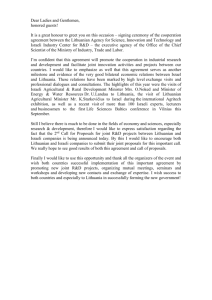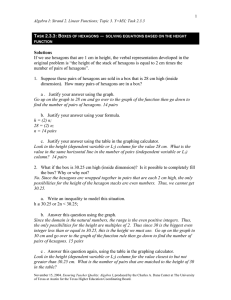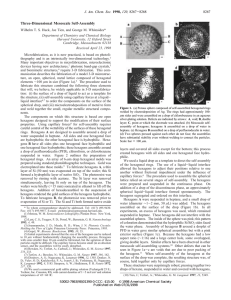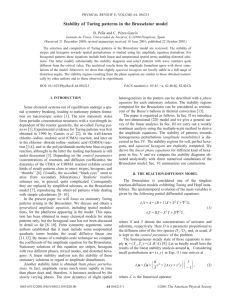Comparison of Students' Understanding of Functions Israel/England
advertisement
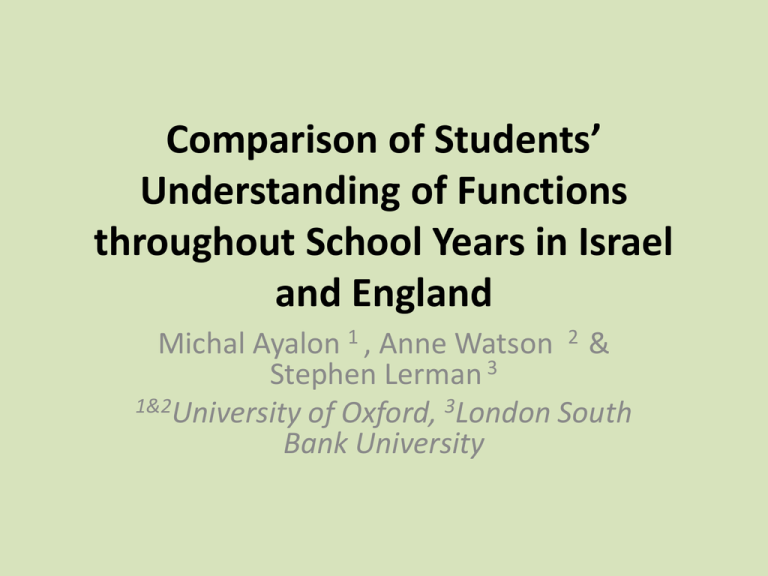
Comparison of Students’ Understanding of Functions throughout School Years in Israel and England Michal Ayalon 1 , Anne Watson 2 & Stephen Lerman 3 1&2University of Oxford, 3London South Bank University Aims of the study • To learn more about how concepts relevant for understanding functions develop, using comparative data from two different curricula systems • Ayalon, Lerman & Watson,2014, BCME; Ayalon, Lerman & Watson 2013, BSRLM 33(2), 7-12 Background about functions • several distinct routes for development of functions through school: – generalisation of sequences – graphical representation of realistic data – sets of points generated from equations/formulae – input/output models – relations and covariation between variables – expressions for mappings between sets – expressions to describe general relationships Key ideas so far • identification of variables: – discrete and continuous – simple or compound • • • • identifying relations between variables recognising covariation correspondence covariation Sample for this paper • highest achieving classes in secondary years • comparable proportions • random anonymised samples of 10 per class – 70 scripts from UK years 7 to 13 – 60 scripts from Israel years 7 to 12 Analysis • • • • grounded, comparative and iterative look for progression in each country compare progressions compare prevalence of approaches Expectations • formal/informal • progression depends on curriculum order and classroom culture • falling off and reappearing v. sustained use v. increased use, therefore we are looking for: – improved results across years – sustained results across years – results that appear to vary across years – curriculum as variable For this presentation • A worrying aspect for Israel • A worrying aspect for England • Task 5 and 2 Task 5 Task 5 • combination of everyday and representational reasoning • difficulties: compound variables and not having 'time' on the x-axis • need a sense of covariation: 'going up and down‘ and varying rate of change • success and difficulties were situation specific across ages • similar approaches and difficulties in both countries, and in the proportions of successful answers • in Israel there was no overall progression that we could discern, the strongest success rate being in year 10 • there was progress in success in England • curriculum and teachers’ reports confirm national differences in approach towards such ideas Task 2 2.1 For 1 hexagon the perimeter is 6 For 3 hexagons the perimeter is 14; For 2 hexagons the perimeter is ________ For 5 hexagons the perimeter is _________ 2.2 Describe the process for determining the perimeter for 100 hexagons, without knowing the perimeter for 99 hexagons. 2.3 Write a formula to describe the perimeter for any number of hexagons in the chain (it does not need to be simplified). Task 2 • Overall success in finding the formula was 99% in Israel compared to 50% in UK. • Correspondence: connect input and output variables – Israeli students choosing this approach, 41/44 presented a correct formula, mainly referring to the structure of the shapes to explain it – the English proportion was 20/39 • 2/3 of the English students made errors of reasoning: – incorrect proportional assumption – not correct construction (starting value) – not correct deconstruction (subtraction) • No Israeli proportional errors; 3 incorrect responses deconstructions • A few Israeli students used two data pairs to find a linear function or AP formulae • Progression was evident in both countries Conjectures • UK curriculum: 'find the formula for the nth term in a sequence’. Israeli curriculum: linear functions not limited to generalising sequences. • Correspondence, e.g. function machines, not connected to generalising sequences • Teaching in Israel appears to circumvent proportional assumptions • UK students were more likely to be successful if they used a covariation approach (15/19) than correspondence. 8/11 Israeli students used this approach successfully. • Israeli students were using methods they had learnt in school; UK students had to adapt learnt methods. • Generalising linear functions is dependent on a range of approaches, and students who understand the purpose can use a bricolage of reasoning Summary • These higher performing Israeli students are less likely to make progress in realistic graph-matching tasks than their English counterparts, while English students are less likely to enact the formal aspects of function understanding, due to having a less formal curriculum. • All students displayed strengths in understanding rate of change, and in identifying key characteristics of graphs, whether formally taught or not. • A worrying weakness in English students is that, despite a strong curriculum focus on generalising linear spatial sequence data, they were less likely to be successful in constructing a formula when data was presented in a nonsequential form. anne.watson@education.ox.ac.uk



